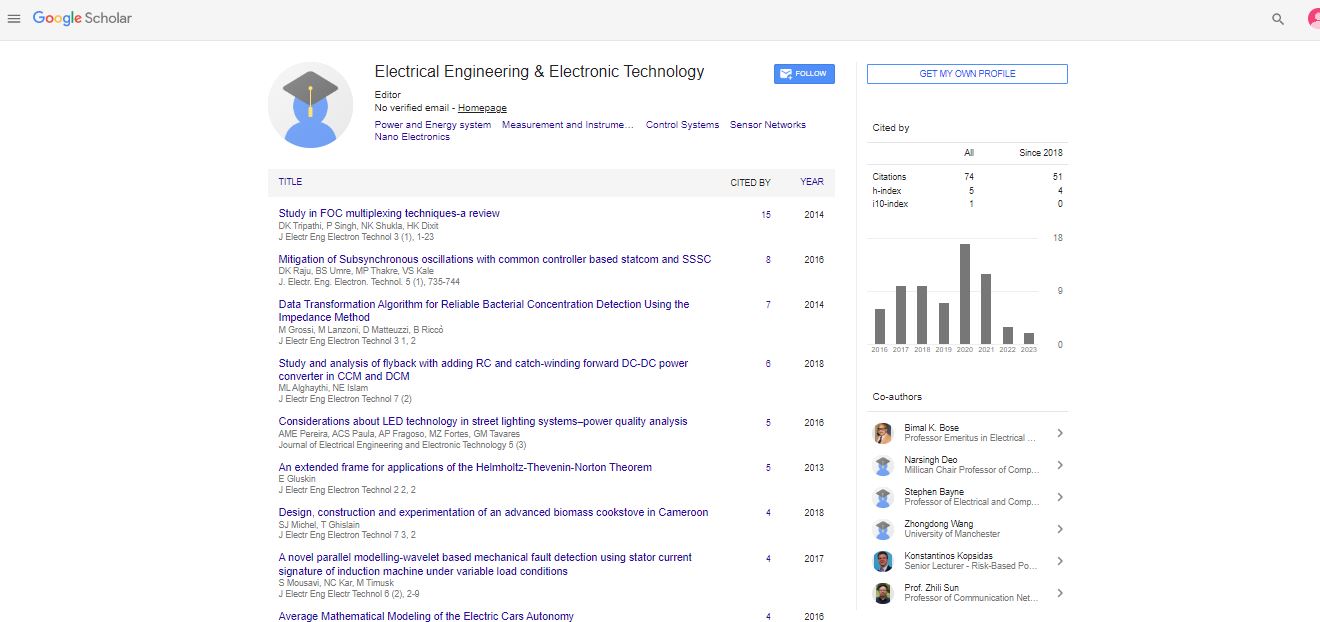Commentary, J Electr Eng Electron Technol Vol: 13 Issue: 4
Microprocessors Unveiled: The Evolution from 4-bit to Multi-core Powerhouses
Greggory Stephen*
1Department of Electrical and Electronic Engineering, Northwestern University, Evanston, IL 60208, USA
*Corresponding Author: Greggory Stephen,
Department of Electrical
and Electronic Engineering, Northwestern University, Evanston, IL
60208, USA
E-mail: stepheng@gmail.com
Received date: 21 June, 2024, Manuscript No. JEEET-24-143450;
Editor assigned date: 24 June, 2024, Pre QC No. JEEET-24-14350 (PQ);
Reviewed date: 8 July, 2024, QC No. JEEET-24-143450;
Revised date: 15 July, 2024, Manuscript No. JEEET-24-143450 (R);
Published date: 22 July, 2024, DOI: 0.4172/2325-9838.1000983
Citation: Stephen G (2024) Microprocessors Unveiled: The Evolution from 4-bit to Multi-core Powerhouses. J Electr Eng Electron Technol 13:4.
Description
Microprocessors are the heart of modern computing, driving everything from personal computers to complex embedded systems. Their evolution from rudimentary 4-bit processors to advanced multicore powerhouses reflects tremendous technological progress. This article explores this evolution, highlighting key milestones and their impact on the computing landscape.
The dawn of microprocessors: The 4-bit era
The journey of microprocessors began in the early 1970s with the advent of 4-bit processors. The Intel 4004, introduced in 1971, is widely recognized as the first commercially available microprocessor. Designed for use in calculators and simple electronic devices, the 4004 featured a 4-bit architecture, which means it could handle 4 bits of data at a time. Limited data handling With a 4-bit architecture, these processors could only process 16 different values, limiting their computational power. Basic functionality they were designed for straightforward tasks, such as arithmetic calculations and simple control operations. Memory addressing 4-bit processors had limited memory addressing capabilities, restricting them to small amounts of memory. Despite these limitations, the 4004 laid the groundwork for future developments in microprocessor technology.
The rise of 8-bit and 16-bit processors
As technology advanced, the limitations of 4-bit processors became apparent, leading to the development of 8-bit and 16-bit processors. The Intel 8080, introduced in 1974, marked the transition to 8-bit processors. This advancement brought several improvements:
Enhanced data handling the 8-bit architecture allowed for more complex operations and supported a wider range of values (256 distinct values). Increased memory 8-bit processors could address up to 64 KB of memory, significantly expanding their capabilities. Broader applications they found use in early personal computers, video game consoles and various industrial applications. The evolution continued with the introduction of 16-bit processors, such as the Intel 8086 in 1978. These processors further improved performance: greater data width the 16-bit architecture enabled handling of 65,536 distinct values, improving computational power and precision.
Expanded memory addressing they could address up to 1 MB of memory, supporting more complex applications and operating systems. Advanced features: 16-bit processors introduced more sophisticated instruction sets and enhanced processing capabilities.
The advent of 32-bit and 64-bit processors
The next major leap came with the introduction of 32-bit processors, exemplified by the Intel 80386 in 1985. This advancement brought about substantial improvements in performance and functionality: improved performance the 32-bit architecture allowed for faster processing of data and more complex instructions. Expanded memory addressing they could address up to 4 GB of memory, supporting more demanding applications and larger data sets. Multitasking 32-bit processors enhanced multitasking capabilities, enabling more efficient handling of multiple processes simultaneously. The evolution continued with the advent of 64-bit processors, such as the Intel Core i7 series. These processors represent a significant leap forward. Enhanced performance 64-bit processors handle larger data sets and perform more complex calculations with greater efficiency. Increased memory addressing they can address vastly more memory (theoretically up to 16 exabytes), supporting modern applications and large-scale data processing. Advanced computing 64-bit processors enable sophisticated features such as virtualization, improved security and enhanced support for high-resolution graphics.
The era of multi-core processors
The latest advancement in microprocessor technology is the introduction of multi-core processors. Unlike single-core processors, which have one processing unit, multi-core processors contain multiple cores on a single chip. Each core can execute instructions independently, allowing for parallel processing and increased performance. Parallel processing multiple cores enable simultaneous execution of multiple tasks, significantly improving overall system performance and responsiveness. Energy efficiency multi-core processors can provide better performance while consuming less power compared to increasing the clock speed of a single-core processor. Scalability they support more demanding applications and workloads, including gaming, data analysis and professional software.
 Spanish
Spanish  Chinese
Chinese  Russian
Russian  German
German  French
French  Japanese
Japanese  Portuguese
Portuguese  Hindi
Hindi 
